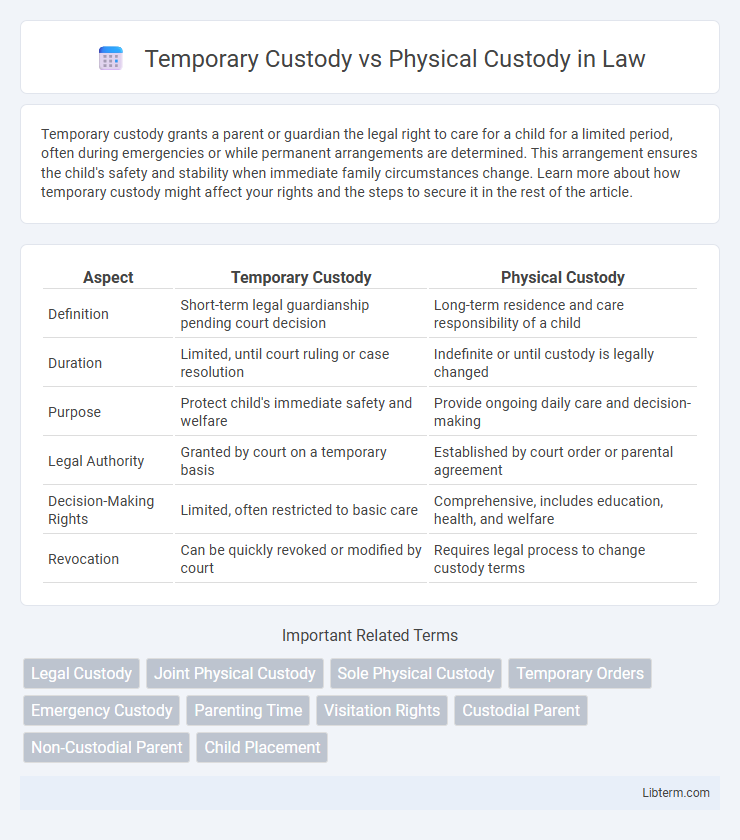Temporary custody grants a parent or guardian the legal right to care for a child for a limited period, often during emergencies or while permanent arrangements are determined. This arrangement ensures the child's safety and stability when immediate family circumstances change. Learn more about how temporary custody might affect your rights and the steps to secure it in the rest of the article.
Table of Comparison
| Aspect | Temporary Custody | Physical Custody |
|---|---|---|
| Definition | Short-term legal guardianship pending court decision | Long-term residence and care responsibility of a child |
| Duration | Limited, until court ruling or case resolution | Indefinite or until custody is legally changed |
| Purpose | Protect child's immediate safety and welfare | Provide ongoing daily care and decision-making |
| Legal Authority | Granted by court on a temporary basis | Established by court order or parental agreement |
| Decision-Making Rights | Limited, often restricted to basic care | Comprehensive, includes education, health, and welfare |
| Revocation | Can be quickly revoked or modified by court | Requires legal process to change custody terms |
Understanding Temporary Custody
Temporary custody refers to the short-term legal responsibility for a child granted to an individual or agency during custody disputes or emergencies, differing from physical custody, which involves the day-to-day care and residence of the child. Understanding temporary custody is essential for parents and guardians navigating family court proceedings, as it determines who has authority and decision-making power before a final custody arrangement is established. Courts typically award temporary custody based on the child's best interests, prioritizing safety, stability, and immediate needs.
Defining Physical Custody
Physical custody refers to the legal right and responsibility to have a child reside with a parent or guardian, ensuring day-to-day care, supervision, and decision-making related to the child's welfare. Temporary custody is a time-limited arrangement granted by the court, often during disputes or emergencies, while physical custody establishes the long-term living situation. Understanding physical custody is crucial in family law as it directly impacts the child's living environment and parenting time allocation.
Key Differences Between Temporary and Physical Custody
Temporary custody refers to the court-ordered care of a child for a limited period, typically during ongoing legal proceedings or until a permanent custody arrangement is decided. Physical custody denotes the actual living arrangement of the child, where the child resides with one or both parents, regardless of legal decision-making authority. Key differences include duration, with temporary custody being short-term and conditional, while physical custody defines the child's daily living environment and can be long-term or permanent.
Legal Basis for Temporary Custody Orders
Temporary custody orders are established based on family law statutes that prioritize the child's immediate safety and well-being during ongoing legal proceedings. Courts rely on evidence demonstrating urgent need, such as risk of harm or neglect, to grant temporary custody, ensuring stable care until a final custody decision is made. Key factors include the child's best interests, parental fitness, and any existing court orders influencing temporary custody arrangements.
When Is Temporary Custody Granted?
Temporary custody is granted when immediate decisions about a child's care are necessary, often during ongoing legal proceedings or emergencies. Courts grant temporary custody to protect the child's welfare until a final custody determination is made. This type of custody ensures stability in living arrangements, schooling, and healthcare while the case is being resolved.
Rights and Responsibilities in Physical Custody
Physical custody grants a parent the right to have their child reside with them and make decisions about daily care, education, and healthcare. Responsibilities in physical custody include providing a safe environment, meeting the child's basic needs, and facilitating a stable routine. While temporary custody may limit these rights to a specific timeframe, physical custody establishes comprehensive, ongoing parental duties essential for the child's well-being.
Duration and Modification of Temporary Custody
Temporary custody typically lasts until a court issues a permanent custody order, often spanning a few months but varying based on case complexity and jurisdiction. Modifications to temporary custody can be requested if significant changes in circumstances arise, such as concerns about the child's safety or parent availability. Courts prioritize the child's best interests, enabling flexible adjustments to temporary custody arrangements before finalizing long-term custody decisions.
Impact on Child’s Well-being
Temporary custody ensures the child's immediate safety and stability during legal proceedings, minimizing disruption by maintaining consistent living arrangements. Physical custody determines the child's primary residence and daily care, shaping their emotional and social development through routine and parental involvement. Both custody types directly influence the child's well-being by addressing their need for security, structure, and nurturing environments.
Factors Courts Consider in Custody Decisions
Courts consider the child's best interests when deciding between temporary custody and physical custody, evaluating factors such as the child's age, emotional and physical needs, and the stability of each parent's home environment. The court assesses each parent's ability to provide basic care, maintain a safe living space, and support the child's educational and medical requirements. Parental mental health, history of abuse or neglect, and the existing parent-child relationship heavily influence custody determinations during the legal process.
Choosing the Right Custody Arrangement for Your Family
Temporary custody allocates parental responsibilities for a limited period, often during legal disputes or emergencies, ensuring stability without altering long-term arrangements. Physical custody determines where a child primarily resides and is crucial in shaping day-to-day routines and emotional well-being. Carefully evaluating your family's needs, legal implications, and the child's best interests helps in selecting the most suitable custody arrangement.
Temporary Custody Infographic

 libterm.com
libterm.com